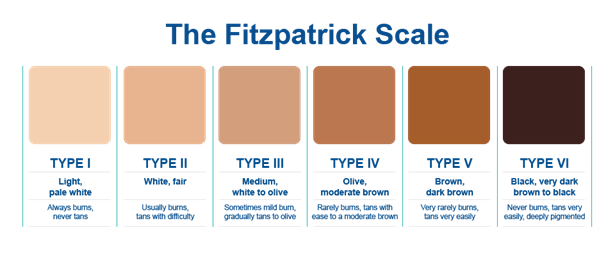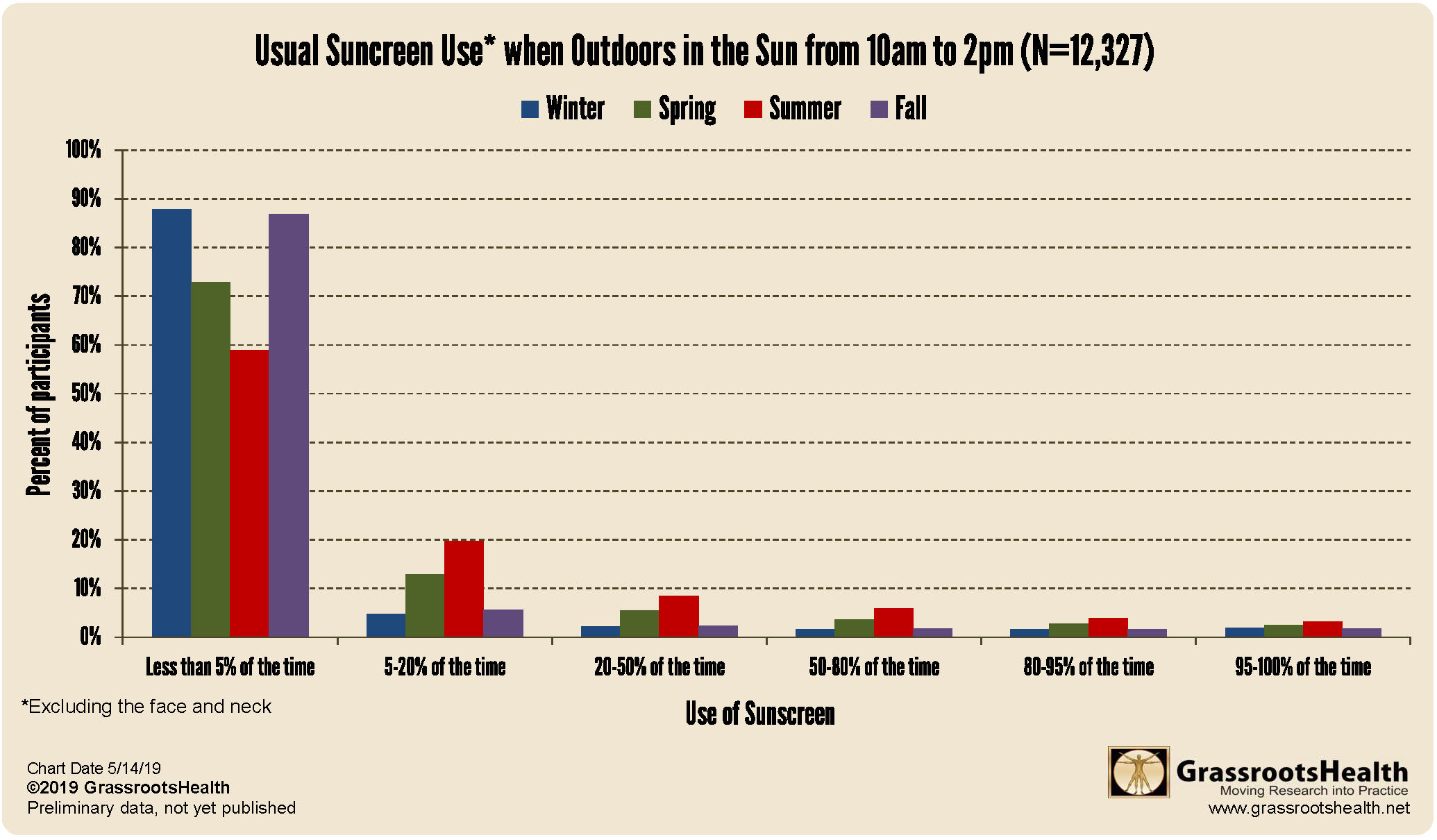Published on May 22, 2019
Sunshine is important for health, but before you soak up the sun’s rays it’s important to assess your situation so that you don’t burn. Sun exposure needs to be individualized according to skin type, UV Index, and the degree to which skin is acclimated to the sun.
Skin Type
Knowing your skin type is important for personalizing your sun exposure. The Fitzpatrick scale, shown below, classifies six skin types based on the response of different skin types to UV radiation. This skin type quiz can help you determine your type.

Credit www.perfectimage-llc.com
The darker your skin, the more melanin it contains and the less likely you are to burn. Melanin acts like a natural sunscreen and while the amount of melanin in skin is primarily genetic, it can also increase gradually through sensible sun exposure. The sun protection factor (SPF) of a natural tan is roughly equivalent to the actual protection of an SPF 50 sunscreen for an average user, considering most users apply only 25% of the recommended amount.
UV Index
The ultraviolet (UV) Index is a measurement of the strength of the sun’s UV rays at a particular place and time. It is a linear scale with higher values representing more intense UV radiation and a greater risk of sunburn. In general, the amount of time that can be spent in the sun before burning is proportional to the UV Index – twice the UV Index, half the time in the sun. An index of 0 occurs at night when there is no UV radiation and an index of 10 corresponds approximately to mid-day summer sunlight without cloud cover (values above 10 can be found in high altitudes, near the Equator, and locations with higher ozone layer depletion). Many factors can affect UV strength such as season, latitude, time of day, altitude, and cloud cover so it’s important to know the specific UV Index in your area when you plan to be outdoors. For vitamin D production, a helpful rule of thumb from one of our expert scientists, Dr. Reinhold Vieth, is that the UV Index should be above 3 and your shadow shorter than you are.

Duration
The amount of time spent in the sun can also be personalized according to skin type and UV Index. Once you have identified your skin type, you can then use tools such as the free app, dminder, to approximate how much time you can spend in the sun without burning. dminder uses EPA burn data, self-reported skin type, location, and current UV Index to approximate when burning might occur and gives you an alarm before that time. Whether or not you choose to use an app, it is important to allow skin to gradually acclimate to the sun, especially for those who spend a lot of time indoors, have lighter skin, after winter months, or during sun-seeking vacations.
Sun protection when your personal limit has been reached
 Once your personal threshold in the sun has been reached, sun protection should be used; this may take the form of going indoors, seeking shade, covering up, or applying sunscreen. While many government agencies recommend always using sun protection, such as daily sunscreen use, this is a mistake according to Dr. Robert Heaney. He states that while sunscreen can be helpful in protecting the skin from burning, sunscreen manufacturers have a vested interest in scaring us into using more of their product. In fact, sunscreen’s ability to prevent skin cancer has been recently called into question by a 2018 study that, after reviewing the existing data, found no evidence of a decreased risk of skin cancer with sunscreen use.
Once your personal threshold in the sun has been reached, sun protection should be used; this may take the form of going indoors, seeking shade, covering up, or applying sunscreen. While many government agencies recommend always using sun protection, such as daily sunscreen use, this is a mistake according to Dr. Robert Heaney. He states that while sunscreen can be helpful in protecting the skin from burning, sunscreen manufacturers have a vested interest in scaring us into using more of their product. In fact, sunscreen’s ability to prevent skin cancer has been recently called into question by a 2018 study that, after reviewing the existing data, found no evidence of a decreased risk of skin cancer with sunscreen use.
What are the sun protection habits among D*action participants?
We ask our D*action participants a few questions about their sun protection habits including the amount of time spent outdoors mid-day, typical outdoor clothing, and sunscreen use. In a previous blog, we showed that a majority (76%) of participants spent 15 minutes or more in the mid-day sun with at least their arms or legs exposed during one or more seasons. The chart below summarizes participants’ usual use of sunscreen, excluding the face and neck, when outdoors in the sun between 10 am and 2 pm for each season. More than half never or almost never use sunscreen across all seasons.
Sun exposure plays an essential role in human health, but must be tailored to the individual to maximize health benefits and avoid burning. Be sure to determine your skin type and the UV Index in your area to assess and personalize your sun exposure.
Are you using sun exposure as a source of vitamin D?
Is sun exposure helping to improve your vitamin D level? Make sure you know your vitamin D level, and see if you are in the target range of 40-60 ng/ml (100-150 nmol/L). Find out your levels today! Log on to the shop (click the link below) to get your tests and see for yourself if your levels can be improved. Use coupon code SunMonth to receive 15% off during Sunshine Month only!
Make sure you track your results before and after, about every 6 months!
Click Here to Access the Shop Page
How can I track my sun exposure and my vitamin D levels?
To help you track your sun exposure and nutrient levels, GrassrootsHealth has created an online tracking system called myData-myAnswers. You can also track your supplemental and dietary nutrient intake to see how they impact your nutrient levels. Check it out today!








